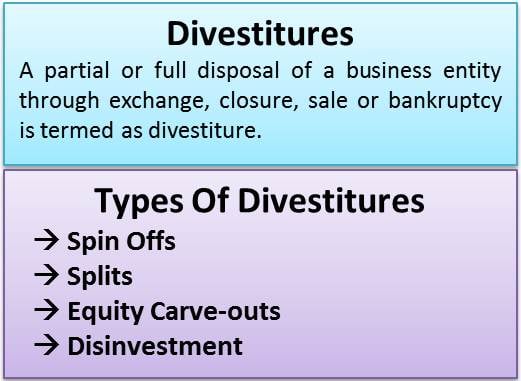Meaning Of Divestitures
Partial or full disposal of a business entity through exchange, closure, sale, or bankruptcy is termed divestiture. A divestiture occurs when the management of an entity decides to stop operating a unit as it is not contributing towards profit. Growth strategies often lead to the divestment of business units.
After understanding the meaning of divestitures, let’s look at the reasons that lead to the same.
Reasons For Divestitures
The following are the reasons that lead to divestitures:
- Huge divisional losses
- Continuous negative cash flows from a particular division
- Difficulty in integrating the business within the company
- Unable to meet the competition
- Better alternatives for investment
- Lack of technological upgradations due to non-affordability
- Lack of integration between the divisions
- Legal pressures
- The market share is too small
On understanding the reasons leading to divestitures, let’s know about the types for the same.
Types Of Divestitures
The following are the types of divestitures:

Spin-Offs
A company creates a subsidiary company. The shares of the new entity are distributed to the parent company’s shareholders on a pro-rata basis. However, the parent company also retains ownership of the spun-off entity. Spin-offs have two approaches that the company can follow.
In the first approach, the company distributes all the shares of the new entity to its existing shareholders on a pro-rate basis. This leads to the creation of two different companies holding the same proportions of equity as compared to the single company existing previously.
The second approach is the floatation of a new entity whose equity is held by the parent company. The parent company later sells the assets of the spun-off company to another company.
Also Read: Spin-Off vs Split-Off
Splits
Splits involve dividing the company into two or more parts. This is done with an aim to maximize profitability by removing stagnant units from the mainstream business. Splits can be of two types, Split-ups and Split-offs.
When a company splits itself into two or more entities, it is called split-ups. In such cases, the parent company loses its existence.
Split-offs are when the shareholders of a parent company surrender their shares in exchange for shares in a subsidiary company. This concept is mainly followed for family businesses when all members cross hold shares in all subsidiaries of the entity. Exchange and conversation of the shares are done to separate the different family streams.
Read more on Spin-Off vs. Split-Off.
Equity Carve-outs
Equity carve-outs are referred to a percentage of shares of the subsidiary company being issued to the public. This method leads to a separation of the assets of the parent company and the subsidiary entity. Equity carve-outs result in publicly trading the shares of the subsidiary entity.
Disinvestment
Disinvestment occurs when a company boycotts or liquidates stocks. The aim of disinvestment is to pressurize a government for a change in rules. Another aim is to pressurize a company or industry for a change in policy.
Also Read: Spin off
After understanding the types of divestitures, we’ll look at an example to get a clearer view.
Example of Divestitures
Hillshire Brands
Sara Lee gave the food industry a big divestitures success. Sara Lee bundled its cheese, cake, meat, and sandwich brands into a new entity called Hillshire Brands. The remaining beverages and baked goods division formed D.E. Master Blenders 1753. The split in the brand benefitted Hillshire brands in a big way and led to wealth maximization.
Conclusion
Divestment of non-profit generating segments holds numerous benefits for the company. The protocol followed for divestment depends on the prevailing market conditions at the time of the transaction. However, the management works on multiple strategies to maximize flexibility in divestitures.
Continue reading on other types of Corporate Restructuring.

